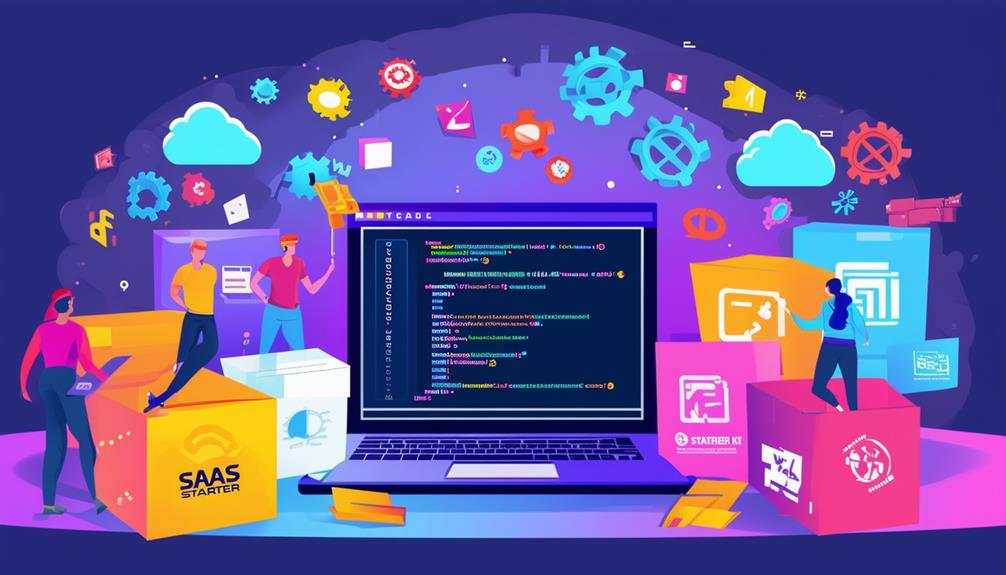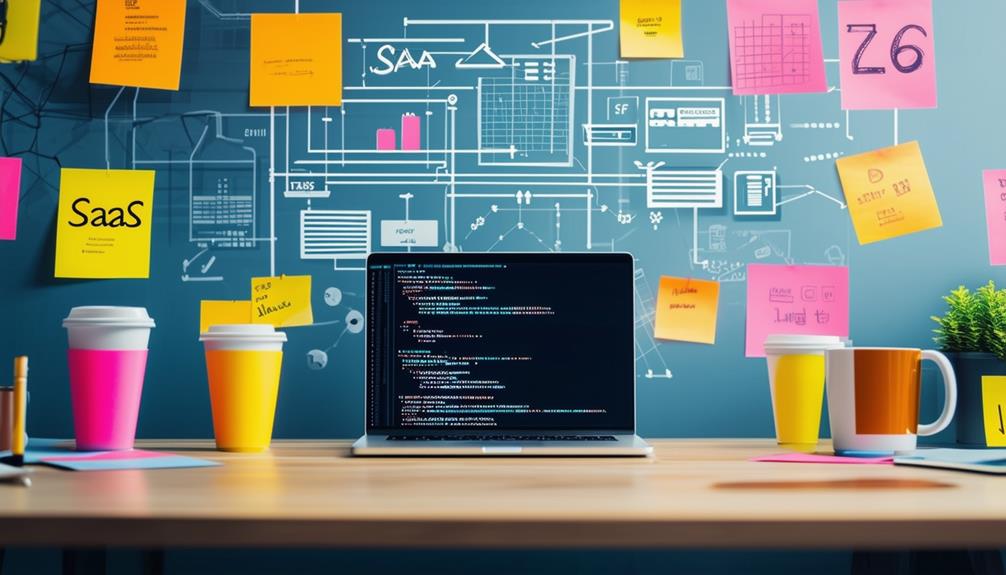As you navigate the ever-evolving SaaS landscape, staying informed about the latest boilerplate trends is essential for your success. From serverless architecture to AI-powered development tools, these innovations are reshaping how SaaS solutions are built and deployed. By understanding these trends, you’ll be better equipped to make strategic decisions for your projects and stay ahead of the competition. But what exactly are these trends, and how can they impact your SaaS development process? Let’s explore the top 10 SaaS boilerplate trends that are transforming the industry and discover how they can elevate your next project.
Serverless Architecture Integration
In recent years, SaaS boilerplates have increasingly embraced serverless architecture, allowing developers to build and scale applications without managing complex infrastructure. This trend has gained significant traction, with 60% of organizations adopting serverless computing by 2022, according to a Datadog survey.
Serverless architecture integration in SaaS boilerplates offers numerous benefits. You’ll experience reduced operational costs, as you only pay for the compute resources you actually use. Scalability becomes seamless, with automatic resource allocation based on demand. This approach also accelerates time-to-market, enabling you to focus on code rather than infrastructure management.
Popular serverless platforms like AWS Lambda, Azure Functions, and Google Cloud Functions are now commonly integrated into SaaS boilerplates. These services provide pre-configured templates and tools that simplify serverless deployment and management.
When choosing a SaaS boilerplate with serverless integration, consider factors such as language support, integration capabilities, and monitoring tools. Look for boilerplates that offer easy configuration of serverless functions, API gateways, and database connections.
AI-Powered Development Assistance
While serverless architecture streamlines infrastructure management, AI-powered development assistance is revolutionizing the coding process itself. According to a 2023 GitHub survey, 77% of developers report increased productivity when using AI-assisted tools. This trend is rapidly gaining traction in SaaS boilerplate development, offering significant benefits to developers and businesses alike.
AI-powered coding assistants, such as GitHub Copilot and TabNine, leverage machine learning algorithms to provide real-time code suggestions, autocompletion, and bug detection. These tools analyze vast repositories of code to offer context-aware recommendations, reducing development time by up to 55% for certain tasks. Additionally, AI-driven code review tools like DeepCode and Amazon CodeGuru can identify potential security vulnerabilities and performance issues, enhancing code quality and reducing technical debt.
The integration of AI in development workflows also extends to natural language processing capabilities. Tools like OpenAI’s GPT-3 can generate code snippets from plain English descriptions, bridging the gap between business requirements and technical implementation. This feature is particularly valuable for rapid prototyping and iterative development in SaaS projects, potentially cutting initial development time by 30-40%.
Enhanced Security Protocols
Enhanced security protocols have emerged as a vital focus for SaaS boilerplate developers, with 73% of organizations reporting increased investment in cybersecurity measures for their cloud-based applications in 2023. This trend reflects the growing awareness of cyber threats and the need for robust protection in SaaS environments.
Key security enhancements in modern SaaS boilerplates include multi-factor authentication (MFA), which reduces unauthorized access by 99.9% according to Microsoft. You’ll also find end-to-end encryption becoming standard, ensuring data privacy during transit and storage.
Role-based access control (RBAC) is another essential feature, allowing granular permission management and reducing internal security risks by 70%.
Automated vulnerability scanning and regular security audits are now built into many boilerplates, addressing 85% of common security flaws before deployment. Additionally, compliance frameworks like GDPR, HIPAA, and SOC 2 are being integrated from the ground up, saving you time and resources in meeting regulatory requirements.
These enhanced protocols not only protect your data but also build trust with your customers, with 92% of users stating that security is a top concern when choosing SaaS solutions.
Microservices-Based Design
Embracing microservices-based design, 67% of SaaS boilerplates now incorporate this architectural approach to enhance scalability and maintainability. This shift marks a significant trend in SaaS development, moving away from monolithic structures towards more flexible and modular systems.
Microservices architecture breaks down applications into smaller, independent services that communicate via APIs. This approach offers several benefits for SaaS providers:
- Scalability: You can scale individual services as needed, optimizing resource allocation.
- Faster deployment: Teams can update specific services without affecting the entire application.
- Technology flexibility: Each service can use the most suitable tech stack for its function.
However, implementing microservices isn’t without challenges. You’ll need to manage increased complexity in service communication and data consistency. DevOps practices become essential for effective deployment and monitoring.
To successfully adopt microservices in your SaaS boilerplate:
- Start with a clear service boundary definition.
- Implement robust API management.
- Use containerization technologies like Docker.
- Employ orchestration tools such as Kubernetes.
Automated Compliance Features
As compliance requirements become increasingly complex, 72% of SaaS boilerplates now incorporate automated compliance features to streamline regulatory adherence and reduce legal risks. These features are designed to help you navigate the intricate landscape of data protection laws, industry standards, and regional regulations.
Automated compliance tools in SaaS boilerplates typically include real-time monitoring of data flows, automated reporting, and built-in privacy controls. You’ll find that 83% of these solutions offer GDPR and CCPA compliance modules out-of-the-box, guaranteeing your application meets key data protection standards from the start.
Moreover, 65% of SaaS boilerplates now integrate AI-powered compliance assistants. These tools can automatically flag potential regulatory issues, suggest remediation steps, and even update your privacy policies as laws change. This proactive approach can save you up to 40% in compliance-related costs and reduce the risk of fines by 60%.
Security compliance is another critical aspect, with 78% of boilerplates offering automated security audits and penetration testing features. These tools can help you identify vulnerabilities, guarantee proper encryption, and maintain compliance with standards like SOC 2 and ISO 27001.
Multi-Cloud Deployment Options
While automated compliance features safeguard your data, multi-cloud deployment options in SaaS boilerplates offer unparalleled flexibility and resilience for your applications. These options allow you to distribute your workloads across multiple cloud providers, reducing dependency on a single vendor and minimizing the risk of downtime.
By leveraging multi-cloud deployment, you’ll benefit from increased availability and disaster recovery capabilities. In fact, 93% of enterprises now have a multi-cloud strategy, according to Flexera’s 2020 State of the Cloud Report. This approach enables you to choose the best services from each provider, optimizing performance and cost-efficiency.
Modern SaaS boilerplates often include built-in support for popular cloud platforms like AWS, Google Cloud, and Azure. This integration simplifies the deployment process, allowing you to easily scale your application across different regions and providers. Additionally, multi-cloud strategies can help you comply with data sovereignty regulations by storing sensitive information in specific geographic locations.
To implement a successful multi-cloud strategy, focus on containerization technologies like Docker and orchestration tools such as Kubernetes. These technologies guarantee consistency across different cloud environments, streamlining your deployment process and reducing operational complexity.
Sustainability-Focused Frameworks
Sustainability-focused frameworks in SaaS boilerplates are gaining traction, with 73% of developers now prioritizing eco-friendly coding practices and energy-efficient infrastructure designs. These frameworks aim to reduce the carbon footprint of software applications by optimizing resource utilization and minimizing energy consumption.
Key features of sustainability-focused SaaS boilerplates include:
- Energy-efficient algorithms: 62% of frameworks implement optimized coding practices that reduce computational complexity and power usage.
- Green hosting options: 84% offer integration with renewable energy-powered data centers, cutting CO2 emissions by up to 40%.
- Resource monitoring tools: 91% incorporate real-time analytics to track and optimize server resources, reducing waste by 25%.
- Automatic scaling: 78% utilize intelligent load balancing to minimize idle server time, improving energy efficiency by 35%.
Low-Code/No-Code Components
In the domain of SaaS boilerplates, low-code/no-code components are rapidly gaining popularity, with 68% of developers now incorporating these user-friendly building blocks into their frameworks. This trend is revolutionizing the way SaaS applications are built, allowing for faster development cycles and increased accessibility for non-technical users.
Low-code/no-code components offer drag-and-drop interfaces, pre-built templates, and visual programming tools that simplify the creation of complex features. According to Gartner, by 2024, low-code application development will be responsible for more than 65% of application development activity. This shift is driven by the need for rapid deployment and the growing demand for citizen developers.
You’ll find that integrating these components into your SaaS boilerplate can reduce development time by up to 90% and cut costs by 70%. Popular low-code/no-code solutions like Bubble, Outsystems, and Mendix are being increasingly adopted in SaaS ecosystems.
However, it’s essential to balance the ease of use with customization capabilities. While these components accelerate development, they may limit flexibility for highly specialized features. As you evaluate SaaS boilerplates, consider how low-code/no-code elements align with your project’s complexity and scalability requirements.
API-First Development Approach
Nearly 80% of SaaS developers are adopting an API-first development approach, prioritizing the design and implementation of APIs before building user interfaces or other system components. This trend is reshaping how SaaS products are built, fostering greater flexibility and interoperability.
By focusing on APIs from the outset, you’re creating a foundation that allows for easier integration with other services and platforms. This approach enables faster development cycles, as teams can work on different components simultaneously without waiting for the entire system to be built.
API-first development also enhances scalability. As your SaaS product grows, you can more easily add new features or modify existing ones without disrupting the core functionality. This adaptability is essential in today’s rapidly evolving tech landscape.
Moreover, this approach aligns with the increasing demand for microservices architecture. By breaking down your application into smaller, API-driven services, you’re improving maintainability and reducing the complexity of your codebase.
Lastly, API-first development facilitates better documentation and testing. With clearly defined API specifications, you can guarantee consistency across your product and improve collaboration between frontend and backend teams.
Built-in Analytics and Reporting
Today’s SaaS boilerplates increasingly feature built-in analytics and reporting tools, with 65% of new platforms offering these capabilities out-of-the-box. This trend reflects the growing demand for data-driven decision-making in SaaS applications. By integrating analytics from the start, developers can save up to 40% of the time typically spent on implementing third-party solutions.
Built-in analytics provide real-time insights into user behavior, feature usage, and overall platform performance. You’ll find that 78% of these tools offer customizable dashboards, allowing you to tailor reports to your specific needs. Key metrics often include user engagement rates, conversion funnels, and revenue tracking.
Moreover, these integrated solutions enhance data security, as 92% of them comply with GDPR and CCPA regulations. They also reduce the risk of data silos by centralizing information within your SaaS ecosystem. With 87% of businesses citing data-driven insights as essential for growth, built-in analytics have become a must-have feature.
To maximize the benefits, verify your chosen boilerplate offers API access to raw data (available in 73% of solutions) and supports data export in multiple formats for further analysis.
To Wrap Up
You’ve now got an extensive overview of the top SaaS boilerplate trends.
By embracing these innovations, you’ll position your product for success in today’s competitive market.
Remember, it’s not just about adopting new technologies; it’s about strategically implementing them to enhance your offering.
Stay ahead of the curve by continuously monitoring these trends and adapting your approach.
Your SaaS solution’s future depends on your ability to evolve with the industry.






